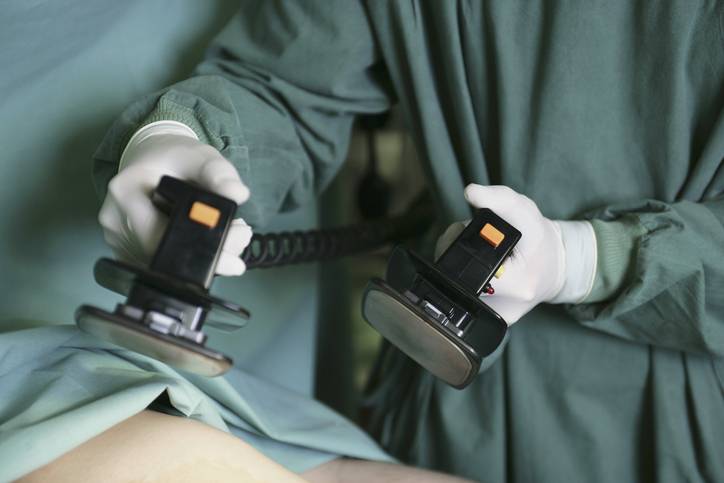A heart attack is one of the most frightening health events, and it can happen without much warning. We’ve all heard of people who suddenly experience chest pain, shortness of breath, or feel dizzy—and then, it’s a heart attack. But did you know that heart attacks don’t always present the same way for everyone? The symptoms can vary, and sometimes, there are no clear signs at all.
In this blog, we’ll break down everything you need to know about heart attacks—from symptoms and causes to treatment and recovery. If you’re worried about your heart health or just want to know how to protect yourself, keep reading!
Contents
What is a Heart Attack?
 A heart attack, also known as myocardial infarction, occurs when the blood flow to a part of the heart is blocked. This blockage prevents oxygen-rich blood from reaching the heart muscle, causing it to become damaged or even die.
A heart attack, also known as myocardial infarction, occurs when the blood flow to a part of the heart is blocked. This blockage prevents oxygen-rich blood from reaching the heart muscle, causing it to become damaged or even die.
How Does a Heart Attack Occur?
Most heart attacks are caused by coronary artery disease (CAD), where the arteries that supply blood to the heart become narrowed or blocked due to a buildup of plaque. Plaque is made up of fat, cholesterol, and other substances in the blood. Over time, this plaque can rupture, leading to the formation of a blood clot. The clot can completely block the blood flow to a part of the heart muscle, leading to a heart attack.
The Role of Blood Clots and Blocked Arteries
-
Blood clots: When the plaque in the artery ruptures, a clot can form, completely blocking the flow of oxygenated blood to the heart.
-
Blocked arteries: The buildup of plaque narrows the arteries, restricting blood flow over time. When this blockage becomes severe, it can cause a heart attack.
Without enough blood flow, the heart muscle begins to suffer damage. If the blockage isn’t cleared quickly, it can lead to long-term heart damage or even be fatal. Quick intervention is critical for preventing major heart damage.
In short, a heart attack is a life-threatening event caused by a blockage in the arteries that prevent blood from reaching the heart muscle, causing it to be starved of oxygen.
Common Symptoms of a Heart Attack

Recognizing the symptoms of a heart attack early can save lives. Here are the most common symptoms to watch out for:
1. Chest Pain or Discomfort (feels like a pressure, tightness, or squeezing in the chest)
-
It can also spread to other areas of the upper body, such as the arms, shoulders, neck, jaw, or back.
2. Shortness of Breath (Difficulty breathing or feeling out of breath)
-
It can be a sign that the heart is not pumping blood properly.
3. Nausea or Vomiting (people feel sick to their stomach, lightheaded, or may even vomit)
- This can sometimes be mistaken for digestive issues, but when it occurs alongside other symptoms, it may be a sign of a heart attack.
4. Pain in the Arm, Jaw, or Back
- This can happen with or without chest pain. It’s often more noticeable on the left side of the body but can affect both sides.
5. Cold Sweat or Clamminess (feeling unusually sweaty, even without physical exertion)
- This can occur suddenly and may be accompanied by dizziness or lightheadedness.
6. Dizziness or Lightheadedness
- This can happen with chest pain or on its own, indicating that the heart is not pumping enough blood to the brain.
Symptoms in Women:
Women may experience symptoms that are less typical compared to men. In addition to the classic chest pain, women are more likely to experience shortness of breath, nausea, extreme fatigue, and pain in the back or jaw. These symptoms can sometimes be subtle and may be easily dismissed, but they should be taken seriously.
Causes of Heart Attacks
Heart attacks are usually caused by a combination of factors that affect the heart and blood vessels. Here are the main causes:
- Coronary Artery Disease (CAD)
- Atherosclerosis, which is a common form of artery disease that is due to the buildup of plaque in the arteries over time, leading to hardening and narrowing of the blood vessels and limiting the flow of blood to the heart and other organs.
- High Blood Pressure (Hypertension)
- High Cholesterol
- Lifestyle Factors That Contribute to Heart Attacks, such as smoking, lack of exercise, diet, stress, etc.
Many of these causes are preventable or manageable with the right lifestyle choices. Addressing these factors can greatly reduce the risk of a heart attack and promote better heart health.
Complications That Can Arise from a Heart Attack
A heart attack can lead to several complications, especially if not treated promptly. Here are some of the potential complications:
- Heart Failure: When the heart is too weak to pump blood effectively after a heart attack.
- Arrhythmias: Irregular heartbeats that can be life-threatening if not managed.
- Stroke: A heart attack increases the risk of a blood clot traveling to the brain, causing a stroke.
- Cardiogenic Shock: When the heart is unable to pump enough blood to the body’s organs, leading to a life-threatening situation.
- Heart Valve Problems: Damage to the heart valves can occur, leading to improper blood flow through the heart.
- Pericarditis: Inflammation of the lining around the heart, causing chest pain.
- Blood Clots: Clots can form in the heart or arteries, leading to further complications or even another heart attack.
It’s important to address these complications with immediate medical care to minimize long-term damage.
How to Prevent a Heart Attack
 Preventing a heart attack involves making healthy lifestyle choices and taking proactive steps to manage your heart health. Here’s how you can reduce your risk:
Preventing a heart attack involves making healthy lifestyle choices and taking proactive steps to manage your heart health. Here’s how you can reduce your risk:
- Exercise Regularly: Aim for at least 30 minutes of moderate exercise most days of the week. Activities like walking, jogging, or swimming help keep the heart strong and improve circulation.
- Eat a Heart-Healthy Diet: Include fruits, vegetables, whole grains, and lean proteins in your diet. Limit saturated fats, trans fats, and sodium to keep your cholesterol and blood pressure in check.
- Manage Stress: Practice stress-reducing techniques like yoga, meditation, or deep breathing. Chronic stress can raise blood pressure and harm your heart over time.
- Quit Smoking: Smoking is a major risk factor for heart disease. Quitting can significantly reduce your risk of heart attack and improve overall heart health.
- Limit Alcohol Consumption: Drinking alcohol in moderation, if at all, is essential. Excessive alcohol raises blood pressure and adds strain to the heart.
- Monitor Your Health: Regularly check blood pressure, cholesterol levels, and blood sugar. Early detection of any issues allows for prompt management and reduces the risk of heart attacks.
By making these lifestyle changes and staying consistent, you can significantly reduce the risk of having a heart attack and maintain a healthier heart.
Treatment Options for Heart Attacks

Immediate and effective treatment is crucial during a heart attack to minimize heart damage and improve recovery. Here’s an overview of the treatment options:
Medications (During a Heart Attack)
- Aspirin: Helps thin the blood and prevent further clot formation, reducing the damage to the heart muscle.
- Clot-Busting Drugs: Medications like thrombolytics dissolve blood clots blocking the coronary arteries, restoring blood flow to the heart.
Surgical Interventions
- Angioplasty: A procedure where a balloon is inserted into the blocked artery to widen it and improve blood flow. A stent may also be placed to keep the artery open.
- Coronary Artery Bypass Surgery (CABG): In cases of severe blockages, bypass surgery reroutes blood around the blocked arteries, improving blood flow to the heart.
Long-Term Recovery Options
- Cardiac Rehabilitation: A program that includes exercise, education, and counseling to help patients recover physically and emotionally after a heart attack.
- Lifestyle Changes: Medication to manage blood pressure, cholesterol, and blood sugar, along with healthy eating and regular exercise, to prevent future heart attacks.
- Medications: Long-term use of medications like beta-blockers, statins, and blood thinners to reduce the risk of further heart issues.
Quick action during a heart attack can save lives and prevent significant damage to the heart. Follow-up care, including lifestyle changes and regular monitoring, is key to long-term recovery and heart health.
Conclusion
Heart attacks are serious, but with quick treatment and the right lifestyle changes, they are manageable. Understanding the symptoms, causes, and available treatment options can help you act fast and prevent long-term damage. Prevention is equally important, so making healthy choices today can protect your heart tomorrow.
If you’re concerned about your heart health or need guidance on prevention, don’t wait. Click the button below to consult an online cardiologist and take control of your heart health today.

